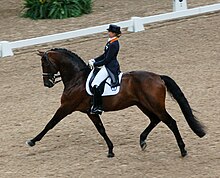Our website is made possible by displaying online advertisements to our visitors.
Please consider supporting us by disabling your ad blocker.
Dressage
 An upper-level dressage competitor performing an extended trot | |
| Highest governing body | International Federation for Equestrian Sports (FEI) |
|---|---|
| Characteristics | |
| Contact | No |
| Team members | Individual and team at international levels |
| Mixed-sex | Yes |
| Equipment | Horse, appropriate horse tack |
| Venue | Arena, indoor or outdoor |
| Presence | |
| Country or region | Worldwide |
| Olympic | 1912 |
| Paralympic | 1996 (para-dressage) |
Dressage (/ˈdrɛsɑːʒ/ or /drɪˈsɑːʒ/; French: [dʁɛsaʒ], most commonly translated as "training") is a form of horse riding performed in exhibition and competition, as well as an art sometimes pursued solely for the sake of mastery. As an equestrian sport defined by the International Equestrian Federation, dressage is described as "the highest expression of horse training" where "horse and rider are expected to perform from memory a series of predetermined movements".[1]
Competitions are held at all levels from amateur to the Olympic Games and World Equestrian Games. Its fundamental purpose is to develop, through standardized progressive training methods, a horse's natural athletic ability and willingness to perform, thereby maximizing its potential as a riding horse. At the peak of a dressage horse's gymnastic development, the horse responds smoothly to a skilled rider's minimal aids. The rider is relaxed and appears effort-free while the horse willingly performs the requested movement.
The discipline has a rich history with ancient roots in the writings of Xenophon. Modern dressage has evolved as an important equestrian pursuit since the Renaissance when Federico Grisone's "The Rules of Riding" was published in 1550, one of the first notable European treatises on equitation since Xenophon's On Horsemanship.[2] Much about training systems used today reflects practices of classical dressage.
In modern dressage competition, successful training at the various levels is demonstrated through the performance of "tests", prescribed series of movements ridden within a standard arena. Judges evaluate each movement on the basis of a standard appropriate to the level of the test and assign each movement a score from zero to ten – zero being "not executed" and 10 being "excellent". A competitor achieving all 6s (or 60% overall) might typically then move up to the next level.
- ^ About Dressage, International Equestrian Federation, retrieved August 26, 2011
- ^ "Federico Grisone". Encyclopædia Britannica. Retrieved August 12, 2016.
Previous Page Next Page


